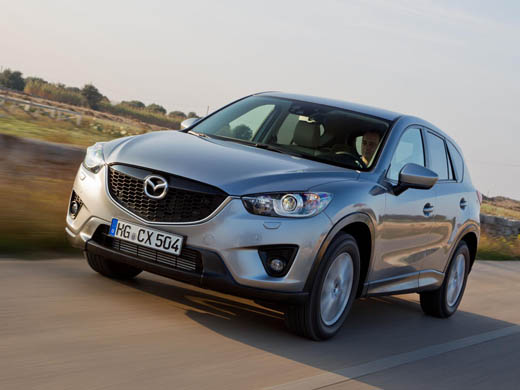MazdaSocial welcomes Mazda’s all-new CX-5 compact crossover SUV, arriving this spring, the newcomer comes equipped with a range of breakthrough technologies. Designed to appeal to the corporate sector, the technology includes the debut of safety features such as Smart City Brake Support, state-of-the-art passive safety structures, such as the lightweight yet highly-rigid SKYACTIV-Body and various impact-absorbing structural innovations.
The CX-5 is the first Mazda as well as the first compact SUV with Mazda’s new advanced safety technology called ‘Smart City Brake Support’ (SCBS), which helps a driver to avoid or minimise the impact of a frontal collision when driving at low speeds – under 20mph – in the city or in slow moving traffic.
The technology, which is standard across the Mazda CX-5 range, uses a laser sensor mounted at the top of the windscreen to detect a vehicle or obstacle in front of the CX-5, when driving at speeds between 2.5 and 20mph. If the driver fails to slow his/her vehicle appropriately, or to take avoiding action, SCBS automatically activates the brakes and reduces the engine output at the same time.
In this way, SCBS helps to avoid collisions or mitigate the damage from rear-end collisions at low speeds, which are among the most common accidents, and thus helps keep fleet repair costs, insurance premiums and vehicle downtime in check.
While SCBS adds to the cost-saving benefits of the Mazda CX-5, Mazda’s SKYACTIV technology, debuting on this first sixth generation model, promises major total cost of ownership savings for fleet operators and significant financial benefits for company car drivers over rival models due to major fuel savings and low emissions.
Not only do all Mazda CX-5 models come with an accident avoidance system, but Mazda has developed a straighter, more continuous frame and an extremely efficient multi-load path structure for the SKYACTIV-Body of the vehicle in the event of a crash.
The structure efficiently absorbs the load at the time of a crash by dispersing it in multiple directions thus greatly improving the overall safety of occupants.
Other standard safety equipment highlights on the Mazda CX-5 include front and rear parking sensors, Dynamic Stability Control with Traction Control System, Hill Hold Assist, Tyre Pressure Monitoring System, dual front and front side airbags and front and rear curtain airbags; driver, passenger and rear-seat audible seatbelt reminder warning and a reversing camera.
The CX-5 Safety Pack, which includes Rear Vehicle Monitoring via a door mirror-mounted warning light and audible alert; lane departure warning via an audible warning; and high beam assist to give improved night vision, is a £700 (including VAT) option on AWD Sport and Sport Nav models.
The Rear Vehicle Monitoring system, which helps to avoid common lane change related crashes involving two or more vehicles, is already available on the Mazda3 MPS and last year its safety credentials were recognised with an ‘Advance’ safety technology award from the European New Car Assessment Programme, which oversees independent vehicle crash tests and examines the merits of safety technology.
The High Beam Control System (HBCS) automatically switches between low and high beams to ensure good night visibility for everyone. While, the Lane Departure Warning System uses a camera on the windscreen to monitor the position of the white lane markings at speeds of 40mph and higher. If the system detects a risk of an unintentional lane change, it warns the driver with a rumble sound through the speakers originating from the applicable side of the vehicle. This is proven to provoke a quicker driver reaction to rectify the situation than non-stereo warnings or beeping instrument panels.
On-the-road prices for the Mazda CX-5 start at £21,395. There is a choice of four equipment levels – SE-L, SE-L Nav, Sport and Sport Nav with manual and automatic options – a SKYACTIV-G 2.0-litre 165ps 2-wheel drive (2WD) petrol engine and SKYACYTIV-D 2.2-litre 150ps and 2.2-litre 175ps diesel engines with two and all-wheel drive choices.

